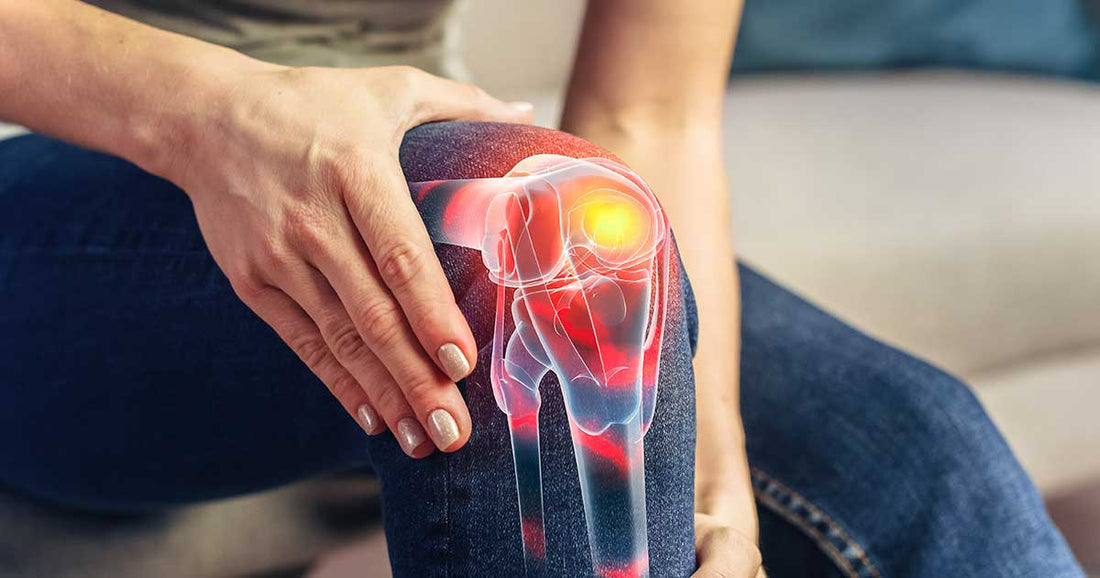
Muscle and Joint Pain and Aging: Natural Ways to Decrease Inflammation
Share
Muscle and joint pain often become more prevalent as we age, affecting our mobility and quality of life. These pains can be attributed to various factors, including wear and tear on joints, decreased muscle mass, and increased inflammation. Fortunately, natural ways to manage and reduce inflammation can help alleviate these aches and pains and improve overall well-being.
Avoiding Inflammatory Foods
One of the most effective ways to decrease inflammation in the body is by avoiding foods that are known to trigger inflammatory responses. Key dietary changes include:
- Eliminating Grains: Grains, particularly refined grains, can cause spikes in blood sugar and contribute to inflammation. Gluten-containing grains such as wheat, barley, and rye can be particularly problematic for those with sensitivities. Opting for grain-free diets or choosing whole, unrefined grains in moderation can help reduce inflammation.[1]
- Avoiding Seed Oils: Seed oils, such as corn, sunflower, and soybean oil, are high in omega-6 fatty acids, promoting inflammation when consumed in excess. Replacing these oils with healthier fats, such as olive, avocado, tallow, and coconut oil, can support a balanced inflammatory response.[2]
- Cutting Out Dairy: Dairy products can be inflammatory for some individuals, especially those lactose intolerant or sensitive to casein, a protein found in milk. Reducing or eliminating dairy can help some people reduce inflammation and joint pain.[3]
- Reducing Sugar Intake: High sugar intake is linked to increased inflammation and a higher risk of chronic diseases. Limiting added sugars and opting for natural sweeteners like honey or maple syrup in moderation can help keep inflammation in check.[4]
Embracing Nutrient-Dense Foods
In addition to avoiding certain foods, incorporating nutrient-dense options can have powerful anti-inflammatory effects:
- Nutrient-Dense Meat: Grass-fed and pasture-raised meats are rich in essential nutrients and healthy fats that support muscle and joint health. These meats contain higher omega-3 fatty acids, which have anti-inflammatory properties.[5]
- Healthy Saturated Fats: Saturated fats from sources like coconut oil, butter, and fatty cuts of meat provide the body with energy and support the production of hormones that regulate inflammation.[6] These fats are also essential for absorbing fat-soluble vitamins crucial for joint and muscle health. Specifically, grass-fed butter and tallow are excellent sources of healthy saturated fats. Grass-fed butter is rich in vitamins A, D, and K2, which are important for bone and joint health, while tallow provides a stable fat ideal for cooking at high temperatures without forming harmful compounds.[7]
- Anti-Inflammatory Foods: Incorporating foods like fatty fish (salmon, mackerel, sardines), nuts, seeds, leafy greens, and berries can provide a rich source of antioxidants and anti-inflammatory compounds that help reduce pain and improve overall health.[8]
Turmeric Curcumin Complex with BioPerine®
In addition to dietary changes, certain supplements can further support the body's anti-inflammatory response. One such supplement is the Turmeric Curcumin Complex with BioPerine®. This blend enhances the body's natural anti-inflammatory mechanisms and offers relief from muscle and joint pain related to systemic inflammation.[9]
Turmeric Curcumin Complex with BioPerine® includes the following benefits:
- Anti-Inflammatory Properties: Turmeric contains curcumin, a powerful anti-inflammatory compound. Curcumin helps reduce inflammation at the cellular level, relieving aches and pains associated with aging and systemic inflammation.
- Enhanced Absorption: The addition of BioPerine®, a black pepper extract, enhances the absorption and bioavailability of curcumin, ensuring that your body can effectively utilize its beneficial properties.
- Antioxidant Support: Curcumin and other compounds in turmeric, such as ar-turmerone, offer antioxidant benefits that protect cells from damage and support overall health. Ar-turmerone also has particular benefits for neuroregeneration, aiding brain health.
- Immune and Digestive Health: Turmeric supports the immune system and promotes digestive and gut health, further contributing to overall well-being.
- Boosts Metabolism: Regular intake of turmeric can help boost metabolism, support energy levels, and aid in weight management.
By incorporating Turmeric Curcumin Complex with BioPerine® into your routine and making strategic dietary changes, you can effectively manage and reduce muscle and joint pain associated with aging. This comprehensive approach will alleviate discomfort and enhance your overall quality of life as you age.
References:
- Everything You Need to Know About Grains In Your Diet.” Healthline, 4 June 2017, https://www.healthline.com/nutrition/grains-good-or-bad.
- Are Seed Oils Bad for You? | Fox Hill Kitchens. 9 Apr. 2021, https://foxhillkitchens.com/are-seed-oils-bad-for-you/.
- Hess, Julie M., et al. “Exploring the Links between Diet and Inflammation: Dairy Foods as Case Studies.” Advances in Nutrition, vol. 12, no. Suppl 1, Oct. 2021, p. 1S.
- Ma, Xiao, et al. “Excessive Intake of Sugar: An Accomplice of Inflammation.” Frontiers in Immunology, vol. 13, 2022.
- Provenza, Frederick D., et al. “Is Grassfed Meat and Dairy Better for Human and Environmental Health?” Frontiers in Nutrition, vol. 6, 2019.
- Health, National Research Council (US) Committee on Diet and. “Fats and Other Lipids.” Diet and Health: Implications for Reducing Chronic Disease Risk, National Academies Press (US), 1989.
- Ph.D, Dr Sanchari Sinha Dutta. “The Health Benefits of Grass-Fed Butter.” News-Medical, 6 Mar. 2024, https://www.news-medical.net/health/The-health-benefits-of-grass-fed-butter.aspx.
- Rahaman, Md. Mizanur, et al. “Natural Antioxidants from Some Fruits, Seeds, Foods, Natural Products, and Associated Health Benefits: An Update.” Food Science & Nutrition, vol. 11, no. 4, Jan. 2023, pp. 1657–70. PubMed Central
- Hewlings, Susan J., and Douglas S. Kalman. “Curcumin: A Review of Its’ Effects on Human Health.” Foods, vol. 6, no. 10, Oct. 2017, p. 92. PubMed Central.
